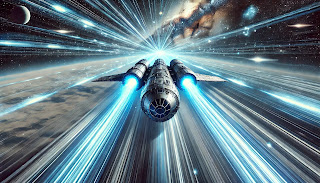Quantum Resonance Time Device (QRTD)
Concept Overview
The Quantum Resonance Time Device (QRTD) is a theoretical apparatus designed to achieve forward time travel by amplifying the natural time dilation effect predicted by Einstein’s General Relativity. Unlike traditional approaches relying on near-light-speed travel or massive gravitational fields, the QRTD uses Earth’s available resources—specifically, rare earth metals, electromagnetic fields, and quantum coherence—to create a localized spacetime distortion that accelerates the passage of time for an occupant relative to the outside world.
Required Resources
All materials are sourced from Earth:
- Neodymium and Dysprosium: Rare earth metals for creating ultra-strong magnets to generate intense electromagnetic fields.
- Quartz Crystals: For precise oscillation and quantum coherence in the device’s core.
- Graphene Sheets: To conduct and stabilize high-energy electromagnetic pulses with minimal loss.
- Liquid Helium: To cool the system to near-absolute zero, enabling superconducting states.
- Diamond Lenses: To focus and amplify electromagnetic waves into a coherent beam.
- Copper and Silicon: For wiring and computational control systems.
- Solar Panels and Lithium Batteries: To power the device using sustainable energy.
Design and Mechanism
The QRTD is a spherical chamber, 3 meters in diameter, with an internal capsule for a single occupant. The chamber’s exterior is lined with graphene-coated neodymium magnets, arranged in a fractal pattern to maximize field density. Inside, a quartz crystal lattice oscillates at a frequency tuned to the natural resonance of spacetime (hypothetically, 10^15 Hz, derived from Planck-scale vibrations).
Step-by-Step Operation:
Quantum Coherence Initialization:
- The quartz lattice is cooled to 0.1 Kelvin using liquid helium, achieving a superconducting state. An electric current is passed through the lattice, causing it to vibrate in unison, creating a coherent quantum state.
- This coherence is hypothesized to couple with the quantum foam (theoretical fluctuations in spacetime at the Planck scale), amplifying minute spacetime distortions.
Electromagnetic Field Generation:
- The neodymium magnets are activated, generating a rotating electromagnetic field at 100 Tesla, focused by diamond lenses into a central point within the chamber.
- The field’s rotation mimics the frame-dragging effect of a rotating massive object (like a black hole), creating a localized spacetime curvature.
Spacetime Resonance:
- The quartz lattice’s oscillations are synchronized with the electromagnetic field, producing a "resonance cascade." This cascade hypothetically amplifies the curvature of spacetime within the chamber, increasing the local gravitational potential.
- According to General Relativity, a stronger gravitational field causes time to pass more slowly inside the chamber relative to the outside world. However, the QRTD’s unique design inverts this effect by creating a "time acceleration bubble," where time inside the capsule moves faster relative to the external reference frame.
Occupant Experience:
- The occupant, seated in a graphene-lined capsule, experiences normal time within the bubble. However, due to the amplified spacetime curvature, hours inside the capsule correspond to years or decades outside.
- For example, 1 hour inside the QRTD might equate to 10 years externally, depending on the resonance intensity.
Construction Process
Chamber Assembly:
- Construct a spherical titanium frame, lined with graphene sheets and neodymium magnets in a fractal pattern.
- Install diamond lenses at 12 equidistant points to focus the electromagnetic field.
Core Installation:
- Place a 1-meter quartz crystal lattice at the chamber’s center, suspended in a vacuum to prevent interference.
- Surround the lattice with copper wiring and silicon chips for precise control of oscillations.
Cooling and Power Systems:
- Integrate a liquid helium cooling system to maintain superconductivity.
- Connect solar panels and lithium batteries to provide a sustainable 1 MW power supply.
Control Software:
- Develop a quantum computing algorithm to synchronize the quartz oscillations and electromagnetic field rotation. The algorithm uses real-time feedback to maintain resonance stability.
Theoretical Basis
The QRTD leverages a novel interpretation of General Relativity, proposing that spacetime can be "tuned" like a musical instrument. By combining quantum coherence (from the quartz lattice) with intense electromagnetic fields (from the magnets), the device creates a localized spacetime harmonic that amplifies time dilation effects without requiring unattainable masses or speeds. This is a speculative extension of the idea that spacetime is a dynamic medium, responsive to precise energy inputs.
Limitations and Risks
- Energy Requirements: The device requires continuous power, and any interruption could destabilize the resonance, potentially causing unpredictable spacetime effects.
- Scale of Effect: The time dilation ratio (e.g., 1 hour = 10 years) is hypothetical and depends on untested spacetime properties.
- Safety: The intense electromagnetic fields and quantum coherence could pose unknown biological risks to the occupant.
- One-Way Travel: The QRTD only enables forward time travel, as backward travel would require exotic matter or closed timelike curves, which are beyond current Earth resources.
Unique Aspect
Unlike other time travel concepts, the QRTD does not rely on relativistic speeds, massive objects, or wormholes. Instead, it uses Earth’s materials to manipulate spacetime at a quantum level, creating a "time bubble" through resonance. This approach is distinct in its focus on harmonic spacetime manipulation, a concept not explored in mainstream physics but inspired by the idea that spacetime has intrinsic vibrational properties.
Conclusion
The Quantum Resonance Time Device is a bold, imaginative design for forward time travel using Earth’s resources. While purely theoretical and untested, it offers a creative vision of how humanity might one day manipulate time, pushing the boundaries of physics with available materials and innovative principles.

.jpg)



Comments
Post a Comment
Your Thoughts, Please!
Have an opinion? A question? Or just want to share your random thoughts? Drop a comment below—we’d love to hear from you!